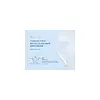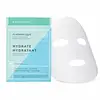What's inside
What's inside
 Key Ingredients
Key Ingredients

 Benefits
Benefits

 Concerns
Concerns

 Ingredients Side-by-side
Ingredients Side-by-side

Water
Skin ConditioningButylene Glycol
HumectantAlcohol
Antimicrobial1,2-Hexanediol
Skin ConditioningBis-PEG-18 Methyl Ether Dimethyl Silane
EmollientPEG-60 Hydrogenated Castor Oil
EmulsifyingPolyacrylic Acid
Emulsion StabilisingSilica
AbrasiveParfum
MaskingEthylhexylglycerin
Skin ConditioningPotassium Hydroxide
BufferingDisodium EDTA
Propanediol
SolventSodium Hyaluronate
HumectantGlycerin
HumectantBHT
AntioxidantBacillus/Soybean Ferment Extract
Skin ConditioningNelumbo Nucifera Flower Extract
Skin ConditioningTocopherol
AntioxidantPrunus Mume Fruit Extract
HumectantCitric Acid
BufferingLactic Acid
BufferingWater, Butylene Glycol, Alcohol, 1,2-Hexanediol, Bis-PEG-18 Methyl Ether Dimethyl Silane, PEG-60 Hydrogenated Castor Oil, Polyacrylic Acid, Silica, Parfum, Ethylhexylglycerin, Potassium Hydroxide, Disodium EDTA, Propanediol, Sodium Hyaluronate, Glycerin, BHT, Bacillus/Soybean Ferment Extract, Nelumbo Nucifera Flower Extract, Tocopherol, Prunus Mume Fruit Extract, Citric Acid, Lactic Acid
Water
Skin ConditioningGlycerin
HumectantDipropylene Glycol
Humectant1,2-Hexanediol
Skin ConditioningTrehalose
HumectantBetaine
HumectantPanthenol
Skin ConditioningEthylhexylglycerin
Skin ConditioningTocopheryl Acetate
AntioxidantButylene Glycol
HumectantPEG-60 Hydrogenated Castor Oil
EmulsifyingPropanediol
SolventInositol
HumectantSodium Hyaluronate Crosspolymer
HumectantTaurine
BufferingHydrolyzed Glycosaminoglycans
HumectantSodium Hyaluronate
HumectantAngelica Gigas Root Extract
Skin ConditioningCimicifuga Racemosa Root Extract
AntimicrobialGlycyrrhiza Glabra Root Extract
BleachingMorus Alba Bark Extract
Skin ConditioningPaeonia Lactiflora Root Extract
Skin ConditioningPhellinus Linteus Extract
Skin ConditioningPolygonum Multiflorum Root Extract
Skin ConditioningScutellaria Baicalensis Root Extract
AstringentSesamum Indicum Seed Extract
Skin ConditioningSophora Flavescens Root Extract
AntioxidantBenzyl Glycol
SolventHydrolyzed Hyaluronic Acid
HumectantHyaluronic Acid
HumectantXanthan Gum
EmulsifyingParfum
MaskingRaspberry Ketone
MaskingWater, Glycerin, Dipropylene Glycol, 1,2-Hexanediol, Trehalose, Betaine, Panthenol, Ethylhexylglycerin, Tocopheryl Acetate, Butylene Glycol, PEG-60 Hydrogenated Castor Oil, Propanediol, Inositol, Sodium Hyaluronate Crosspolymer, Taurine, Hydrolyzed Glycosaminoglycans, Sodium Hyaluronate, Angelica Gigas Root Extract, Cimicifuga Racemosa Root Extract, Glycyrrhiza Glabra Root Extract, Morus Alba Bark Extract, Paeonia Lactiflora Root Extract, Phellinus Linteus Extract, Polygonum Multiflorum Root Extract, Scutellaria Baicalensis Root Extract, Sesamum Indicum Seed Extract, Sophora Flavescens Root Extract, Benzyl Glycol, Hydrolyzed Hyaluronic Acid, Hyaluronic Acid, Xanthan Gum, Parfum, Raspberry Ketone
Ingredients Explained
These ingredients are found in both products.
Ingredients higher up in an ingredient list are typically present in a larger amount.
1,2-Hexanediol is a synthetic liquid and another multi-functional powerhouse.
It is a:
- Humectant, drawing moisture into the skin
- Emollient, helping to soften skin
- Solvent, dispersing and stabilizing formulas
- Preservative booster, enhancing the antimicrobial activity of other preservatives
Butylene Glycol (or BG) is used within cosmetic products for a few different reasons:
Overall, Butylene Glycol is a safe and well-rounded ingredient that works well with other ingredients.
Though this ingredient works well with most skin types, some people with sensitive skin may experience a reaction such as allergic rashes, closed comedones, or itchiness.
Learn more about Butylene GlycolEthylhexylglycerin (we can't pronounce this either) is commonly used as a preservative and skin softener. It is derived from glyceryl.
You might see Ethylhexylglycerin often paired with other preservatives such as phenoxyethanol. Ethylhexylglycerin has been found to increase the effectiveness of these other preservatives.
Glycerin is already naturally found in your skin. It helps moisturize and protect your skin.
A study from 2016 found glycerin to be more effective as a humectant than AHAs and hyaluronic acid.
As a humectant, it helps the skin stay hydrated by pulling moisture to your skin. The low molecular weight of glycerin allows it to pull moisture into the deeper layers of your skin.
Hydrated skin improves your skin barrier; Your skin barrier helps protect against irritants and bacteria.
Glycerin has also been found to have antimicrobial and antiviral properties. Due to these properties, glycerin is often used in wound and burn treatments.
In cosmetics, glycerin is usually derived from plants such as soybean or palm. However, it can also be sourced from animals, such as tallow or animal fat.
This ingredient is organic, colorless, odorless, and non-toxic.
Glycerin is the name for this ingredient in American English. British English uses Glycerol/Glycerine.
Learn more about GlycerinParfum is a catch-all term for an ingredient or more that is used to give a scent to products.
Also called "fragrance", this ingredient can be a blend of hundreds of chemicals or plant oils. This means every product with "fragrance" or "parfum" in the ingredients list is a different mixture.
For instance, Habanolide is a proprietary trade name for a specific aroma chemical. When used as a fragrance ingredient in cosmetics, most aroma chemicals fall under the broad labeling category of “FRAGRANCE” or “PARFUM” according to EU and US regulations.
The term 'parfum' or 'fragrance' is not regulated in many countries. In many cases, it is up to the brand to define this term.
For instance, many brands choose to label themselves as "fragrance-free" because they are not using synthetic fragrances. However, their products may still contain ingredients such as essential oils that are considered a fragrance by INCI standards.
One example is Calendula flower extract. Calendula is an essential oil that still imparts a scent or 'fragrance'.
Depending on the blend, the ingredients in the mixture can cause allergies and sensitivities on the skin. Some ingredients that are known EU allergens include linalool and citronellol.
Parfum can also be used to mask or cover an unpleasant scent.
The bottom line is: not all fragrances/parfum/ingredients are created equally. If you are worried about fragrances, we recommend taking a closer look at an ingredient. And of course, we always recommend speaking with a professional.
Learn more about ParfumPeg-60 Hydrogenated Castor Oil comes from hydrogenated castor oil. It is a solubilizer and emulsifier.
As a solubilizer, it helps dissolve ingredients into a water-based version. It is also an emulsifer. Emulsifier help prevent oils and water from separating. Both these properties help create evenly-spread and uniform products.
Basically, Peg-60 Hydrogenated Castor Oil helps hold ingredients together.
Learn more about PEG-60 Hydrogenated Castor OilPropanediol is an all-star ingredient. It softens, hydrates, and smooths the skin.
It’s often used to:
Propanediol is not likely to cause sensitivity and considered safe to use. It is derived from corn or petroleum with a clear color and no scent.
Learn more about PropanediolSodium Hyaluronate is hyaluronic acid's salt form. It is commonly derived from the sodium salt of hyaluronic acid.
Like hyaluronic acid, it is great at holding water and acts as a humectant. This makes it a great skin hydrating ingredient.
Sodium Hyaluronate is naturally occurring in our bodies and is mostly found in eye fluid and joints.
These are some other common types of Hyaluronic Acid:
Learn more about Sodium HyaluronateWater. It's the most common cosmetic ingredient of all. You'll usually see it at the top of ingredient lists, meaning that it makes up the largest part of the product.
So why is it so popular? Water most often acts as a solvent - this means that it helps dissolve other ingredients into the formulation.
You'll also recognize water as that liquid we all need to stay alive. If you see this, drink a glass of water. Stay hydrated!
Learn more about Water